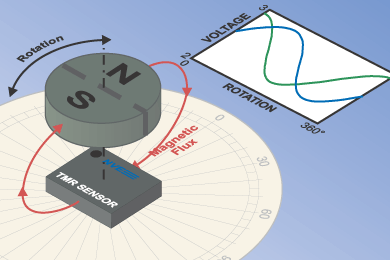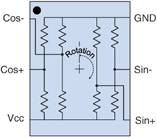NVE Introduces Full-Bridge TMR Angle Sensor AAT101 provides 400 millivolts per volt peak-to-peak output signals with no amplification EDEN PRAIRIE, Minn.—September 5, 2017—NVE Corporation (Nasdaq: NVEC) today announced the introduction of the AAT101-10E Full-Bridge Tunneling Magnetoresistance (TMR) Angle Sensor, a high-output magnetic sensor for angle measurements based on rotating magnetic fields.  The new sensor has two full-bridge outputs for double the output signal. The full-bridge configuration allows direct replacement of semiconductor sensors, providing larger output signals and lower power.  Typical
applications include rotary encoders, and motor shaft position sensors, and Internet-of-Things
end nodes. Typical
applications include rotary encoders, and motor shaft position sensors, and Internet-of-Things
end nodes.The AAT101 typical device resistance is 625 kilohms for low power consumption, and the sensor can run on a single button cell or harvested power. Harvested power can be intermittent, and AAT-Series sensors detect and maintain absolute position information, and immediately power up in the correct position when power is restored. Other AAT101 features include: • 625 kilohm device resistance for low power and battery operation • Sine and cosine outputs for direction detection • 400 millivolts per volt peak-to-peak output signals • 1.5% maximum nonsinusoidality error • Ultraminiature 2.5 by 2.5 by 0.8 millimeter TDFN6 package AAT-Series sensors use unique Tunneling Magnetoresistance (TMR) elements for large signals and low power consumption. Also known as Spin-Dependent Tunneling (SDT), Magnetic Tunnel Junction (MTJ), or Tunneling Magnetic Junction (TMJ), Tunneling Magnetoresistance is a spintronic quantum effect that produces a dramatic resistance change in a normally insulating layer, depending on the magnetic field and thus the predominant electron spin in a free layer. The sensors provide sine and cosine signals defining the angle of rotation. Outputs are proportional to the supply voltage and peak-to-peak output voltages are much larger than conventional sensors. Because they are resistive devices with no active components, AAT-Series sensors have no minimum supply voltage and can be powered from single cells. The AAT101 is the fifth member of the groundbreaking AAT Angle Sensor family. The other four part types have half-bridge outputs. The AAT009 has six megohm typical device resistance for ridiculously low power consumption; the AAT003 has 20 kilohm output impedances for direct interface to microcontrollers; and the AAT006 operates at magnetic fields as low as 15 oersteds. Available now, AAT101-10E Low-Field Angle Sensors are priced at $2.23 each in 1,000-piece quantities. Datasheets and more information are available at www.nve.com. NVE is a leader in the practical commercialization of spintronics, a nanotechnology that relies on electron spin rather than electron charge to acquire, store and transmit information. The company manufactures high-performance spintronic products including sensors and couplers that are used to acquire and transmit data. NVE has also licensed its spintronic magnetoresistive random access memory technology, commonly known as MRAM. Statements used in this announcement that relate to future plans, events, or performance are forward-looking statements that are subject to certain risks and uncertainties including, among others the risk factors listed from time to time in our filings with the SEC, including our Annual Report on Form 10-K and other reports filed with the SEC. ### |